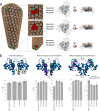Structural basis for HIV-1 capsid adaption to a deficiency in IP6 packaging
- PMID: 40890096
- PMCID: PMC12402280
- DOI: 10.1038/s41467-025-63363-9
Structural basis for HIV-1 capsid adaption to a deficiency in IP6 packaging
Abstract
Inositol hexakisphosphate (IP6) promotes HIV-1 assembly by stabilizing the immature Gag lattice and becomes enriched within virions, where it is required for mature capsid assembly. Previously, we identified Gag mutants that package little IP6 yet assemble particles, though they are non-infectious due to defective capsid formation. Here, we report a compensatory mutation, G225R, in the C-terminus of capsid protein (CA) that restores capsid assembly and infectivity in these IP6-deficient mutants. G225R also enhances in vitro assembly of CA into capsid-like particles at far lower IP6 concentrations than required for wild-type CA. CryoEM structures of G225R CA hexamers and lattices at 2.7 Å resolution reveal that the otherwise disordered C-terminus becomes structured, stabilizing hexamer-hexamer interfaces. Molecular dynamics simulations support this mechanism. These findings uncover how HIV-1 can adapt to IP6 deficiency and highlight a previously unrecognized structural role of the CA C-terminus, while offering tools for capsid-related studies.
© 2025. The Author(s).
Conflict of interest statement
Competing interests: The authors declare no competing interests.
Figures







Update of
-
Structural basis for HIV-1 capsid adaption to rescue IP6-packaging deficiency.bioRxiv [Preprint]. 2025 Feb 9:2025.02.09.637297. doi: 10.1101/2025.02.09.637297. bioRxiv. 2025. Update in: Nat Commun. 2025 Sep 1;16(1):8152. doi: 10.1038/s41467-025-63363-9. PMID: 39975075 Free PMC article. Updated. Preprint.
References
-
- Bell, N. M. & Lever, A. M. HIV Gag polyprotein: processing and early viral particle assembly. Trends Microbiol.21, 136–144 (2013). - PubMed
MeSH terms
Substances
Grants and funding
- BB/S003339/1/RCUK | Biotechnology and Biological Sciences Research Council (BBSRC)
- K99 AI174891/AI/NIAID NIH HHS/United States
- R01 AI178846/AI/NIAID NIH HHS/United States
- 206422/Z/17/Z/Wellcome Trust (Wellcome)
- U54 AI170791/AI/NIAID NIH HHS/United States
- 101021133/EC | EU Framework Programme for Research and Innovation H2020 | H2020 Priority Excellent Science | H2020 European Research Council (H2020 Excellent Science - European Research Council)
- 311427/Z/24/Z/Wellcome Trust (Wellcome)
- P50 AI150481/AI/NIAID NIH HHS/United States
- P50AI150481/U.S. Department of Health & Human Services | NIH | National Institute of Allergy and Infectious Diseases (NIAID)
- WT_/Wellcome Trust/United Kingdom
LinkOut - more resources
Full Text Sources

